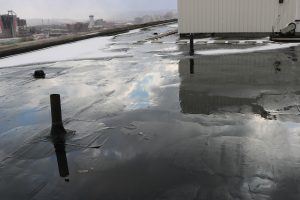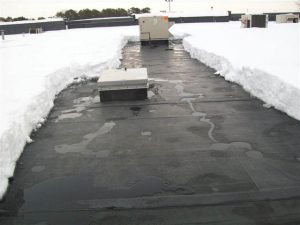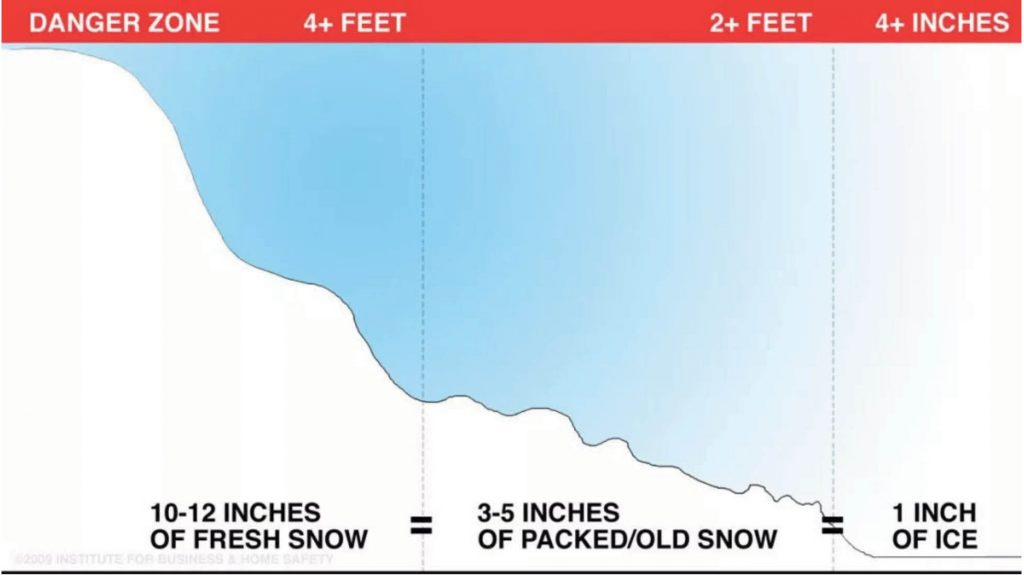— By Marian Noletti —
How to handle any of the winter woes on your commercial roof.
In many parts of the country, the winter season is known for bringing extreme cold temperatures, increased precipitation and high winds. These weather elements are rough on all of us for sure, but they can be even rougher on restaurant and retail roofs.
Freeze. Thaw. Repeat.
Dramatic temperature fluctuations cause repeated freezing, thawing and refreezing of water throughout the winter season. This vicious cycle often results in ice dams and icicles. While ice formations may be pretty to look at, they can wreak havoc on roofs and gutter systems.

Marian Noletti, Simon Roofing
These temperature changes also allow water to easily seep into extremely small cracks or seams on a roof. It then expands as it freezes, which enlarges those openings. This resulting expansion and contraction from repeated freeze-thaw cycles has proven to have a negative effect on the reliability and longevity of commercial roofs.
Flashing refers to impervious material installed on a roof to waterproof critical areas by securing joints and covering exposed gaps. This type of weather-resistant barrier system is basically designed to keep moisture out. Unfortunately, though, flashing is vulnerable to high winds and ice formation.
Ponding Water
 When the water from melted snow and ice doesn’t properly drain or naturally evaporate, it has nowhere to go but stay on the roof. Ponding water is defined as any water remaining on a roof for more than 48 hours. Open seams and cracks allow ponding water to penetrate the roofing membrane, which commonly causes damage to the roof deck, leads to wet insulation and result in leaks. Wet insulation is especially dangerous for both restaurant and retail facilities because it can attract insects, rodent infestations, mold and poor indoor air quality.
When the water from melted snow and ice doesn’t properly drain or naturally evaporate, it has nowhere to go but stay on the roof. Ponding water is defined as any water remaining on a roof for more than 48 hours. Open seams and cracks allow ponding water to penetrate the roofing membrane, which commonly causes damage to the roof deck, leads to wet insulation and result in leaks. Wet insulation is especially dangerous for both restaurant and retail facilities because it can attract insects, rodent infestations, mold and poor indoor air quality.
Condensation
Buildings with inadequate insulation and/or poor ventilation run the risk of having an area that allows the warm air from inside of the building to escape and reach the cold roof. This often results in condensation, which is obviously more common during winter months. If left unaddressed, it can lead to mold, mildew and other damage.
Wind
High winds any time of the year can result in damaged flashings, open seams and torn laps —all of which can cause roof leaks.
Snow
 Most restaurant and retail roofs are low slope or flat, making them more prone to snow buildup. The buildings these roofs protect also have a maximum weight limit, so it’s important to be aware of the amount and weight of snow and drifts on your roof. Exceeding the maximum weight can dramatically affect your roof’s structural integrity.
Most restaurant and retail roofs are low slope or flat, making them more prone to snow buildup. The buildings these roofs protect also have a maximum weight limit, so it’s important to be aware of the amount and weight of snow and drifts on your roof. Exceeding the maximum weight can dramatically affect your roof’s structural integrity.
The chart pictured below compares the relative weights of fresh snow, packed snow and ice — showing the accumulation of each needed to hit the roof collapse danger zone of 20 lbs./square foot. (Graphics courtesy of Insurance Institute for Business and Home Safety.) At that weight, snow should be professionally removed from the roof whenever possible.

For more guidance, you may want to check out FEMA’s Snow Load Safety Guide (FEMA P-957/January 2013).
Winter Best Practices for Your Commercial Roof
The good news is facility managers can get a step ahead of these winter weather issues by following some simple best practices.
- Schedule a professional inspection that can ensure your roof is ready for the harsh conditions of winter. It’s always best to schedule these inspections in the fall and spring each year — or before and after winter, which is the time when your roof is most likely to experience its toughest wear and tear.
- Develop a plan for proactive roof maintenance during winter months. This has proven to pay for itself over and over again by both helping to minimize roof repair expense and extending the useful life of the roof.
- Establish a relationship with a reliable commercial roofing company that you can trust now instead of waiting until an emergency arises. This will help prevent you from scrambling when a leak appears.
- Inspecting the roof yourself can prevent leaks. Roof cracks and other penetrations can be vulnerable to water from snow and rain, which can lead to wet insulation, rotting roof decks, structural damage to walls and ceilings inside the building, mold growth, insects, and more. If you detect any anomalies, contact your roofing partner to promptly address small issues before they become a major problem.
- Accessing your roof during cold winter months for inspections or utility work can be dangerous, particularly early mornings and after dark. Ensure that anyone who has to be on your roof knows the safest paths around weak spots or skylights, follows safety guidelines and exercises caution when performing work.
Following these tips will help to avoid building damage, structural damage, and employee/customer injuries — all of which can come with the roofing challenges of winter weather.
— Marian Nolletti is a co-owner of Simon Roofing, a national commercial roofing manufacturer and contractor that offers repairs, restorations, replacements, preventative maintenance, evaluations and roof asset management. For more information, call 800.523.7718 or visit www.simonroofing.com.

